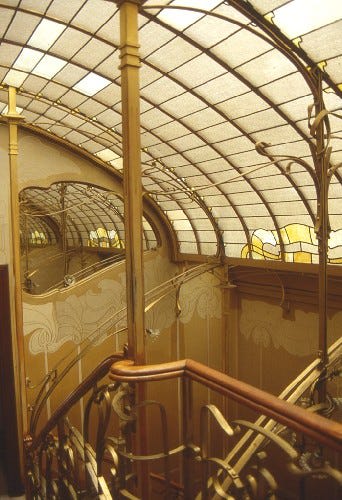Published on October 7, 2025 3:50 AM GMT

Last year, after the first Progress Conference was held in Berkeley, I wrote a blog post suggesting that we need a similar conference in Europe, perhaps even more than it is needed in America. Then, a couple of months ago, I got a message from Bahadir Sirin of GPRG letting me know that such a conference is actually going to happen.
How cool is it when people have the same idea and make it happen, without you having to lift a finger! Huge thanks to Bahadir and everyone involved!
The conference took place in Brussels on September 26th, and what follows are a few brief notes from the event.
I didn’t attend the original Berkeley conference, so I can’t compare directly, but here’s what Kevin Kohler, who went to both, has to say:
Despite being a conference aimed at reviving European ambition, the level of ambition was lower than in the US. In SF houseparties people predict what year we’ll have a Dyson Sphere, in Europe we discuss which energy forms should count as renewable in the EU’s energy degrowth plan.
Now, that might be a little unfair. This isn’t really about the US versus the EU, but rather about Silicon Valley versus the rest of the world. I don’t see people in Washington, D.C., discussing Dyson spheres either.
That being said, there’s some truth to it. Europe does feel less ambitious. On this topic, I think that Rasheed Griffith from the Carribean Progress Studies Institute has a point: Fix the capital markets, and most stuff is downstream from there. If discussing Dyson spheres at houseparties would make you look cool and lure investors to finance your startup, the chat about Dyson spheres is what you’ll get.
To give a different example, EU-Inc, a unified legal entity for European business, easy to create and run and spanning all 27 countries would be absolutely helpful. But with easy access to capital, even Europe’s notoriously annoying corporate law(s) would get much less frustrating. If nothing else, you could hire someone to stand in queues for you.
There are enough people capable of executing ambitious projects in Europe. There’s also a lot of money to invest. What’s missing is the way to connect the two. With better ways to finance ambitious projects, the overall level of ambition would naturally rise, without much additional effort.
The conference was a lot about policy, much less about the industry. Which, it seems, was partly a deliberate choice. The conference was held in Brussels, to be close to EU institutions. Also the focus was on EU, as a political entity, rather than on Europe as a continent, which made it less interesting for the people from UK, where Progress movement has already put down roots.
But if one truly believes that the main obstacles to progress in Europe are political, that what’s missing isn’t human capital or clever ideas, but rather institutional infrastructure needed to make things happen, then it’s hard to argue with the choice. We could have talked the European industry to death, but as long as every promising startup packs up and leaves for the US, it wouldn’t help one bit.
It surprised me was how often the word “democracy” was brought up. Growth can occur in democracy as well as in autocracy, so speaking about democracy, Acemoglu’s paper aside, feels somewhat orthogonal to the topic.
An uncharitable explanation might be that everything-bagel mentality finds its way even into the progress crowd. (Translation for Europeans: It’s Eintopf mentality. If we can talk about democracy on top of progress, why not add it to the pot? The more ingredients, the better the stew.)
A more charitable explanation is that people see the current dysfunction in European institutions as a function of lacking democracy. As an example, take Luis Garicano’s recent article, arguing that the process of selection of the Commission guarantees that we will always end up with weak and incapable leaders. I’ve made a take on a similar topic, from a bit different angle, here.
Speaking of EU dysfunction, I went to a café on Sunday and picked up a two-year-old, dust-covered local magazine from the shelf. It was complaining about the ongoing troubles with rebuilding Schuman roundabout, the junction right in front of the Berlaymont building, the seat of the European Commission.
Then, I opened my laptop and read a Politico article from just last week. It was complaining, you’ve guessed it, about ongoing troubles rebuilding the Schuman roundabout.
By the way, I’ve learned from the local magazine that Berlaymont building was built on the site of the bulldozed-down Convent of the Ladies of Berlaymont, a religious institution devoted to the education of young ladies. Not relevant in any way, but funny nonetheless.
There wasn’t much discussion of my personal hobbyhorse, the absence of a common European public square, or, for that matter, anything resembling a shared European public opinion. In Europe, issues and policies are debated within individual countries, while almost no public discourse goes on at the European level. And what we can’t discuss, we can’t fix.
Building some kind of common place for discussion and a functional blog-to-policy pipeline would help a lot. But of course, we are speaking of 24 different languages and 27 different media landscapes, so it’s not exactly easy.
As already said, the conference was organized in Brussels to get it close to the EU institutions but the choice of venue was also symbolic in its way.
Walking around Brussels, you can’t help but notice the sheer number of Art Nouveau buildings everywhere. (When it comes to Art Nouveau, I rank Brussels as No. 1, just ahead of Budapest and Vienna. Fight me, good citizens of the city of Vienna!)

All that architecture is the legacy of the Belle Époque, a time when progress reigned supreme in Europe. Dyson spheres? Give me a break! In 1910, we had an actual project to build a staircase inside the Matterhorn, all the way to the top.
As for the background, it’s not a widely known fact that Belgium was the second country to industrialize — from 1830’s on, right after Britain, and before Germany, France, and Switzerland jumped on the bandwagon.
Which meant that by 1890, when Art Nouveau came into vogue, the city was booming and the nouveau riche were building their homes in that style.

And by the way, the city of Brussels is doing a good job of keeping the Art Nouveau spirit alive. Just compare the Horta House above to the interior of the local trams!
It’s also worth comparing Brussels with Paris. Paris had much stricter regulations on facade design, giving the city its unified, Haussmannian look. Yes, it has an impressive, imperial feel to it, but if you ask me, I like the libertarian hodgepodge of Brussels better.
And finally, the worn-down state of many of these Art Nouveau buildings, the thick layer of dust, the peeling paint, the graffiti, is a reminder that progress, if left unattended and ignored, will slow down and eventually turn into decay.
Discuss


